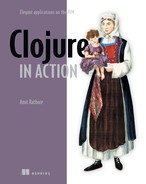List of Figures
Chapter 1. Introduction to Clojure
Chapter 4. Polymorphism with multimethods
Chapter 5. Clojure and Java interop
Chapter 6. State and the concurrent world
Figure 6.1. A reference that points to completely different immutable values over time
Chapter 7. Evolving Clojure through macros
Figure 7.1. Phases of the Clojure runtime. This separation is what makes the macro system possible.
Chapter 9. Data storage with Clojure
Figure 9.1. Output from the scan "clojure_test" command issued at the HBase shell
Chapter 10. Clojure and the web
Figure 10.1. How an HTTP request flows through the Ring framework
Chapter 11. Scaling through messaging
Chapter 12. Data processing with Clojure
Chapter 13. More on functional programming
Chapter 14. Protocols, records, and types
Chapter 15. More macros and DSLs
